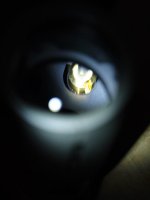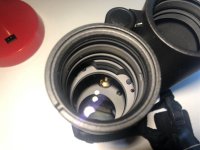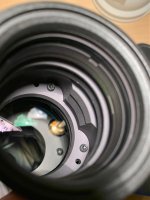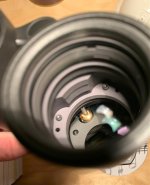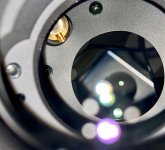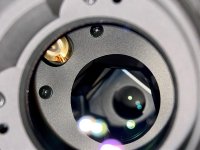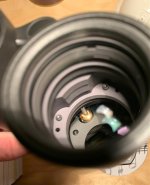Tobias Mennle
Well-known member
I have owned the Noctivid over a year now in which I have mostly used the Nikon EDG instead. The name seems program - the Noctivid is great in low or subdued light, but probably much more due to a strongly boosted contrast by skewing the transmission curve than due to more transmissive glass. Similar to Zeiss and Swarovski SLC.
But the Nocti seems to hate strong light flowing through it. I got frustrated by the level of veiling glare that makes the images dull and flat. It is an often very weak glare, just hardly noticeable unless you play around trying to shield the objectives, but it destroys contrast. The extreme sharpness of the glass counteracts this a bit.
Finally I used a torch and have a closer look through the objectives - see attached image. Should have done that on day one and will do on day one with all new purchases.
An unblackened, unbaffled, very reflective brass knob at the base of the focuser axis. It can easily be hit by sunlight and will scatter part of it back into the image path.
This is either a serious design flaw, or Leica just forgot a baffle when assembling my glass - could other Noctivid owners check on their samples, please, if there is a baffle? The Ultravid 8x32 is completely baffled.
I assume it is a design flaw though because I could provoke heavy flare in the 10x42 I had.
Sic transit gloria mundi.
Such stuff has happened before though, for example in the 8K APO Summicron 50/2, where lens rims were not been blackened etc.
The contrast boost due to skewed transmission is much more aggressive than in the Ultravids. I don't buy Leica´s statement of a whiter image at all but I'm happy to be taught otherwise after the contrast issue is solved. Colours are a tad on the yellow green side but without proper global contrast it is a useless discussion anyway. As always, it shows in the shadows and midtones, not in the highlights. Black dogs and male blackbirds look on the brownish side of things when they are a cold black seen with the Nikon EDG.
Ergonomy is a huge step back from the Ultravids.
The Nikon EDG, although it does have many annoying flaws, is my reference glass for global contrast and colour accuracy, employing no artificial contrast boost whatsoever.
Here is my (hopefully preliminary) review. The Noctivid has great potential but with this issue it is a shame for Leica.
http://www.greatestbinoculars.com/allpages/reviews/leica/noctivid8x42/noctivid8x42.html
But the Nocti seems to hate strong light flowing through it. I got frustrated by the level of veiling glare that makes the images dull and flat. It is an often very weak glare, just hardly noticeable unless you play around trying to shield the objectives, but it destroys contrast. The extreme sharpness of the glass counteracts this a bit.
Finally I used a torch and have a closer look through the objectives - see attached image. Should have done that on day one and will do on day one with all new purchases.
An unblackened, unbaffled, very reflective brass knob at the base of the focuser axis. It can easily be hit by sunlight and will scatter part of it back into the image path.
This is either a serious design flaw, or Leica just forgot a baffle when assembling my glass - could other Noctivid owners check on their samples, please, if there is a baffle? The Ultravid 8x32 is completely baffled.
I assume it is a design flaw though because I could provoke heavy flare in the 10x42 I had.
Sic transit gloria mundi.
Such stuff has happened before though, for example in the 8K APO Summicron 50/2, where lens rims were not been blackened etc.
The contrast boost due to skewed transmission is much more aggressive than in the Ultravids. I don't buy Leica´s statement of a whiter image at all but I'm happy to be taught otherwise after the contrast issue is solved. Colours are a tad on the yellow green side but without proper global contrast it is a useless discussion anyway. As always, it shows in the shadows and midtones, not in the highlights. Black dogs and male blackbirds look on the brownish side of things when they are a cold black seen with the Nikon EDG.
Ergonomy is a huge step back from the Ultravids.
The Nikon EDG, although it does have many annoying flaws, is my reference glass for global contrast and colour accuracy, employing no artificial contrast boost whatsoever.
Here is my (hopefully preliminary) review. The Noctivid has great potential but with this issue it is a shame for Leica.
http://www.greatestbinoculars.com/allpages/reviews/leica/noctivid8x42/noctivid8x42.html




